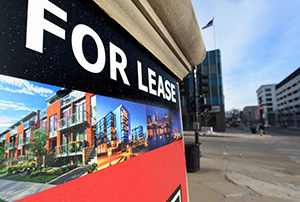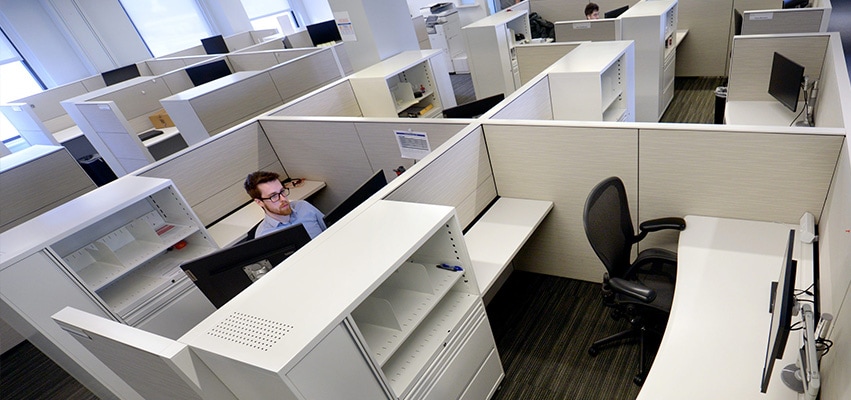March 2020: COVID arrives and employees across the region and state find themselves in unfamiliar, sometimes confusing territory, unable to go into the office and having to create work spaces in their homes.
March 2022: Many employees have concluded that commuting to the family room couch or dining room table for work has its advantages, at least a few days a week. Many employers are making it happen.
From Pearl Companies in Peoria Heights to OSF HealthCare, CEFCU and CliftonLarsonAllen LLP in Peoria, many central Illinois employers now offer a remote work option. What started as a temporary measure to contend with COVID now looks as if it may be here to stay, as employers try to remain competitive for talent, a portion of which wants that come-and-go flexibility.
About 75 percent of Pearl’s 400 workers across the country – two-thirds of them at its headquarters in Peoria Heights, where it’s the largest employer – are working from afar, said CEO Gary Pearl.
The insurance, marketing and technology services firm had plans to invest up to $10 million in expanding/renovating its Heights headquarters, but has shelved those blueprints, for now, in the wake of COVID, he said.
OSF did go ahead with its Ministry headquarters, as it was well into renovation and construction when COVID hit. The facility originally intended to house upwards of 700 workers now has 500 permanent residents, with some 175 now on a hybrid schedule between home and office. Again, the pandemic compelled the rethinking of longstanding workplace philosophies, said executives there.
 Working remotely also is a popular option for the 100 employees at the Peoria office of CliftonLarsonAllen LLP (CLA), a professional services firm. Roughly 10 percent of employees prefer to distance themselves full-time, said Mark Dalbey, CLA Managing Principal for Central Illinois.
Working remotely also is a popular option for the 100 employees at the Peoria office of CliftonLarsonAllen LLP (CLA), a professional services firm. Roughly 10 percent of employees prefer to distance themselves full-time, said Mark Dalbey, CLA Managing Principal for Central Illinois.
Meanwhile, “a greater percentage of employees said they need flexibility, yet don’t want to work from home every day,” he said. “We can make that work.”
Employees with young children now have the freedom to pick them up from school, or those with elderly parents to take them to a doctor’s appointment. Others just like the comfort and convenience.
“March 2020 was a shock,” Dalbey acknowledged. However, because the firm had remote infrastructure in place, it was able to avoid a complete shutdown. Indeed, with technology such as Zoom, employers have the ability to let people work from anywhere.
“As long as the jobs are getting completed, we don’t care if they are at the office or in their basement,” Dalbey said.
That said, the company’s mantra is “better together,” he said. With 22,000 square feet of space in the company’s Downtown office in the top two floors at 301 SW Adams, there is plenty of room for social distancing.
“Our office has been fortunate to have minimal COVID cases,” Dalbey said.
CEFCU employs more than 900 people throughout its branches, with about 50 to 60 working from home, said Community Relations Manager Martha Kamp.
“We do have a number of employees who have switched to working at home completely and don’t even have a desk in our main office,” she said. Others are on hybrid schedules.
“It is a good strategy, as we are a growing company,” said Kamp. Indeed, the company can use the extra space, and plans to continue with the work-from-home option moving forward, with policies to govern the practice and a corporate team dedicated to overseeing that transition, she said.
Empty offices in Peoria

Nearly one-third of the office space in Peoria is empty.
Vacancies increased from 23 percent in January 2021 to nearly 32 percent in January 2022, said Tom Camper, commercial real estate broker with Joseph & Camper Commercial in Peoria. Much of that vacant space is downtown.
He was not surprised by that exodus and does not expect much change in the next few years. “Employees are working from home, and it will continue,” Camper predicted.
Although the survey was limited to the city of Peoria, Camper said he’d expect similar vacancy rates in Tazewell and Woodford counties.
Prior to the 2008 recession, local office vacancies were stable, under 12 percent. That doubled following the economic downturn. Office leasing and sales have been slow for a decade.
“Last year, out of all the deals that we have done, there were just five or six for office leasing or sales. That is a small percentage of the deals we do,” Camper said. Sales of land for professional office space are nearly non-existent.
Looking ahead, Camper expects many buildings to be repurposed, citing the example of Riverview Plaza, which was converted into apartments.
Better or worse?
A quality workforce is the lifeblood of any company, and many employers feel like they don’t have any choice but to offer remote work if they want to stay in the game. Others will confide that it’s less than ideal and nothing replaces the direct office interaction and resulting productivity.
OSF CEO Bob Sehring notes the healthy collaboration, the “casual collisions” of people and ideas that can result when workers are under one roof.
It’s more difficult now to maintain a company culture, said Pearl, who is giving his employees “a great deal of leeway” but still losing some. An environment has been created “where people that typically wouldn’t be looking for a job are now looking because they’re getting calls from headhunters saying you can move to this company, make more money and still work from home.”
For Dalbey at CliftonLarsonAllen, it’s not hard to imagine companies looking at their brick-and-mortar locations and asking, “Why pay for this if less space is needed?”
“Remote working is not going to go away,” he said. “Coming out of COVID won’t look the same as going into it.”
Sally McKee is a journalist and former managing editor of the Journal Star in Peoria. Editor-in-chief Mike Bailey also contributed to this report.




